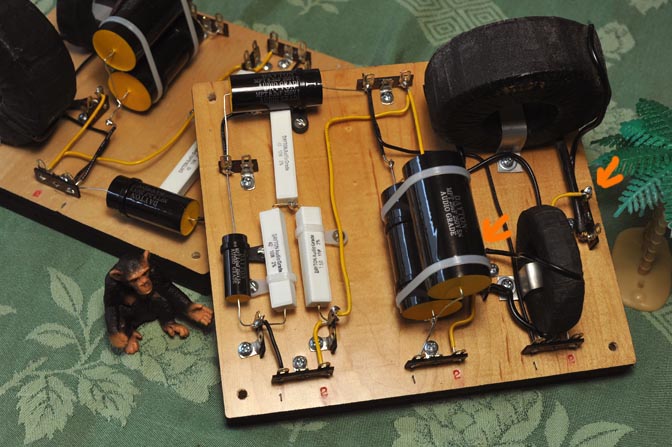Note that I have Al tweeters, but paper mids - an uncommon mix. [...] Last week I put two bath towels over the mids - ah, much better. Today I rewired the tweeter L-pads to control the mid instead. Better. Much better.
I'm surprised that your B-209 need to be muffled. I doubt this is effects of the sonotube, which should be minor. Maybe resonance? Did you have the sonotue internally lined? I doubt that much matters, but the justification for the slanted sides of the flowerpot vs. the sonotube is to reduce standing waves and exciting resonance. No, I'm concluding this is not the problem.
Your midrange is not polarity reversed, correct? That will make it much too forward and altering the polarity makes it sound peculiar. (Yes, I've elsewhere posted Bob Betts' justification for why Bozak made that change, but for many of us a reversed midrange does not sound right.) Could this be the issue? See below.
Added an L-pad to the tweeters, hated them. Dammit. [...] Raised the front 1.5". Even better.
The paper-cone B-209 is 9 dB quieter than the (9 dB louder) aluminum-cone B-200Y or B-200Z tweeter. This causes imbalances, but not of the sort you describe. It would require attenuating the tweeter, not the midrange.
Do you still have the tweeters in front of the woofers? Dispersion might be the problem, but I'm thinking reversed midrange (see below) because you want it muffled a bit.
I'm going to run them this way for a bit and see. I still stand by my earlier post - I should have left them stock with a fresh re-cap. Well... maybe not. I will say that the Tobin mod did wonders with the woofer - much stronger and controlled sound - very impressed with that part of the mod. Moving the woofer/mid cross over was good too.
Tobin does three things: (1) moves crossover point down, (2) un-reverses midrange polarity change, (3) tape impedance rise of tweeter and attenuate for balance. Ok, that's sort of four things, but I'm lumping the tweeter mods together. The Zobel is not going to cause issues, but the attenuation does, which is why I have suggested switching to an L-Pad. Biggles had the same issues we all have had and reported the balance was much better with an L-Pad.
So the issue is, I think, either an un-reversed or reversed (it was proper polarity but was switched in the rebuild) midrange.



